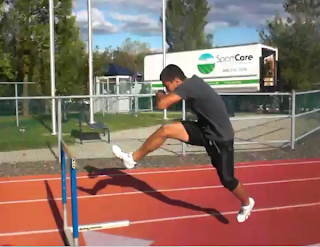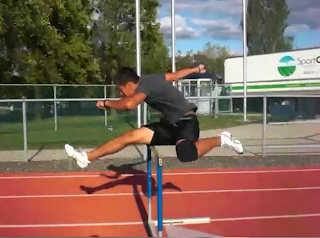Wednesday, December 8, 2010
Squats exercise
Trail leg drill
*Your trail leg needs to have a smooth range of motion above the hurdle, in this drill you will be implementing muscle memory therefore making it easier for you to get over the hurdle with the right form. In this drill you will be bringing your trail leg over the hurdle using the right form, a way of practicing in details without having to be going at full speed over the hurdle.
Wednesday, October 13, 2010
Lead Leg Drill
Being able to explode and have a good lead leg form in very crutial, you can put a hurdle infront of a wall but if you're home and still want to practice you can simply place a chair infront of a wall. This exercise focuses on muscle memory by doing this exercise you are teaching your muscles the biomechanics of bringing the lead leg up using your quadriceps and at the same time focusing on the running form.
Wednesday, September 22, 2010
Increase speed
*Obviously in a hurdle race you want to go as fast as possible using our fast-twitch muscles, to increase your speed it is important to have the right running form, it's also important to not overstride, and keep the form while running over the hurdle
*In this demostration my right leg will be my lead leg and my left leg will be my trail leg, but that can change deppending on the hurdler.
Lead Leg
*After obtaining enough velocity and have approach to the hurdle the right distance, push off the floor with your trail leg using you quads, gastrocnemius, and soleus to mane a few muscles. In my case it would be my left; some hurdlers use the other leg.
*You push off with your trail leg and bring your other leg, which is the lead leg, in my case my right, foward and make it straight, parrallel to the ground, aiming just above the hurdle.
Attack hurdle
*As you attack the hurdle, focus on bringing your lead leg (right) straight just above the hurdle, at the same time, you push off the floor with your trail leg (left) off the floor to start bringing it up. Make sure your upper limbs are in right form and your torso is leaning foward.
trail leg
*At this point your lead leg (right) is on top of the hurdle, momemtum is going to keep you going foward so focus on bringing your trail leg (left) to it's right form; Your knee will be flexed and your leg abducted, next to your hip, parallel to the floor. At this point you will reach the apex point
mid-air form
*This would be the climax, your center of gravity will be above the hurdle. At this point make sure to keep your running form, lead leg (right) straight, trail leg (left) bent parrallel to the floor, with your torso leaning foward.
*Remember to keep your running form.
trail leg foward
*Following the climax, bring your lead leg (right) down to the floor, this will happen automatically due to gravity, but at the same time start bringing your trail leg (left) infront of you to use it as your next step foward using with full range of motion.
Trail leg next step
*When landing on the ball of your foot with lead leg (right), push off of it to help bring ur trail leg (left) foward, making it ur next step to increase momentum.
Keep momentum going
*After landing and pushing off with the lead leg, make sure to keep the momemtum going this way speed is not lost by maintaining velocity.
Terms definitions
Lower limbs: They are referred to as the "legs"
Upper limbs: They are referred to as the "arms"
Hamstring: Refers to one of the three posterior thigh muscles.
Quadriceps: A large muscle of four muscles on the front of the thing.
Stamina: The capacity of a person to endure physical stress to achieve some objective.
Endurance: The power to withstand hardship or stress.
Hypertrophy: Is the increase in the volume of an organ or tissue.
Fatigue: Temporary loss of strength and energy resulting from hard physical or mental work.
ROM: The distance and direction a joint can move to its full potential.
Muscle memory: Involves consolidating a specific motor task into memory through repetition.
Biomechanics: The application of mechanical principles to biological systems.
Fast-twitch muscles: Type 2 muscles mostly used in fast, explosive movements.
Overstride: Forcing a longer step than your normal range.
Velocity: Is speed in a given direction. ( Speed = Distance/Time).
Parallel: Some going in the same direction and will never meet.
Torso: The body excluding the head and neck and limbs
Momentum: Product of the mass of an object and its velocity.
Flexed: To contract a muscle.
Abduct: Movement of body part away from the body.
Apex: The highest point (of something).
Ball of foot: Where the toes join with the rest of the foot.
Subscribe to:
Comments (Atom)







